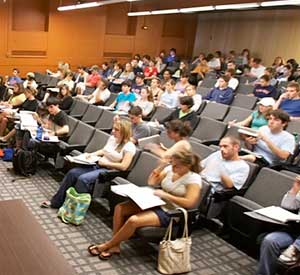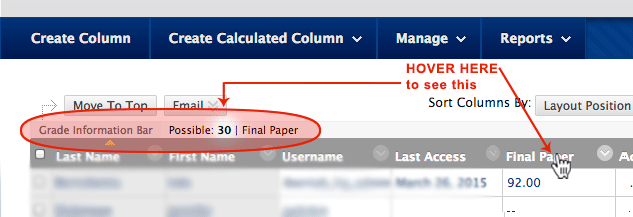 It’s that time of year again when faculty are thinking about how to better engage their students in the classroom. The first class meeting can often set the tone for the whole semester, and establishing norms for classroom interactions goes a long way towards creating a more welcoming and respectful learning environment for everyone.
It’s that time of year again when faculty are thinking about how to better engage their students in the classroom. The first class meeting can often set the tone for the whole semester, and establishing norms for classroom interactions goes a long way towards creating a more welcoming and respectful learning environment for everyone.
One way you can help students feel more invested in these guidelines is to develop them together in class, and it is helpful to do this early on so that you can fall back on them, if needed, during the course of the semester.
Below are some examples from UVM faculty:
From Helen Read, Mathematics:
CLASSROOM ETIQUETTE: In order that we make the most of our class time, please make every effort to arrive on time and stay until class is dismissed. Please be respectful of the instructor and your fellow students, and refrain from any behavior that would distract from our work. Turn off and put away cell phones, music players, etc., before class begins, and close email, games, and anything else you have running on the computer that is not directly related to what we are doing in class.” H.P. Read – http://www.cems.uvm.edu/~hpread/math022/math022I_syllabus.pdf
Another example from Shirley Gedeon, Economics:
Classroom Etiquette & Policies
In class, address the professor as “Professor Gedeon”
In emails, start off with “Dear Professor Gedeon”
It’s a large auditorium, but I want to answer questions. I will do my very best to move around the room to make it easier to hear your questions. I welcome and respect all political and economic points of view and expect all students to do likewise.
Professor Gedeon writes and grades all exams.You have the right to petition grading on any question on any exam. Protocol for submitting petitions will be discussed in class.
The Teaching Assistant grades all homework. You have the right to petition grading on any homework assignment. Protocol for submitting petitions will be discussed in class.
Shirley Gedeon – http://www.uvm.edu/~econ/documents/Gedeon-EC11Aspring2014.pdf
If you are teaching a class in which a number of sensitive topics will be discussed, it is even more critical to layout a thoughtful approach to classroom etiquette. This following example is from a syllabus for Introduction to Sexuality & Gender Identity Studies taught in 2010 by Reese Kelly:
Classroom Etiquette:
Out of respect for other students and the instructor, you should arrive in class on time and stay until class is over. Coming and going in the middle of a lecture is highly disruptive. Turn off your cell phones while you are in class. To be fair, my rule is that if your cell phone goes off in class, I get to answer it. Likewise, if mine goes off in class, you get to answer it.
If the use of computers or cell phones becomes disruptive to anyone in the class, including yourself, you may be asked to leave class. Recording lectures and using laptops to take notes is allowed as long as these activities are not disruptive.
Eating during lectures is discouraged, but drinks are acceptable.
You must enter the course willing to suspend, challenge, or even change many of your taken-for granted beliefs about gender, race, size, ability, nationality, sex, sexuality, class and so on. This is often difficult because the multiple layers of our identities are so deeply embedded in our daily lives including our sense of self and our intimate relationships.
You will find that being willing to examine multiple perspectives on an issue is your most important and useful tool for understanding the concepts we discuss in class. In this course, we will be covering some sensitive and controversial topics. Some of the issues we discuss may make you feel uncomfortable at times. However, in order for learning to occur, we must act respectfully towards each other, even if there is some disagreement. If, at any time, your behavior is viewed as disruptive to the class, you will be asked to leave. Personal attacks, rude comments, or harassment of any kind (racial, sexual, etc.) will NOT be tolerated! If you experience a personal attack, harassment, or if you feel as though your classmates are spoiling your learning environment, please inform me.
Reese C. Kelly, http://www.uvm.edu/~wmst/documents/Kelly075fall2010syllabus.pdf
A few more to look at:
Brian Ballif, https://www.uvm.edu/~biology/Classes/223/documents/Bio223Syllabus.pdf
Alison Pechenick, http://www.cems.uvm.edu/~amp/cs20sum13/
Larry Kost, http://www.cems.uvm.edu/~lkost/classroom_etiquette.htm
Enjoy the start to the semester!
 We are pleased to announce that we are accepting applications for the 2015-16 cohort of the Sustainability Faculty Fellows Program. Applications are due on October 12, 2015.
We are pleased to announce that we are accepting applications for the 2015-16 cohort of the Sustainability Faculty Fellows Program. Applications are due on October 12, 2015.

 It’s that time of year again when faculty are thinking about how to better engage their students in the classroom. The first class meeting can often set the tone for the whole semester, and establishing norms for classroom interactions goes a long way towards creating a more welcoming and respectful learning environment for everyone.
It’s that time of year again when faculty are thinking about how to better engage their students in the classroom. The first class meeting can often set the tone for the whole semester, and establishing norms for classroom interactions goes a long way towards creating a more welcoming and respectful learning environment for everyone.